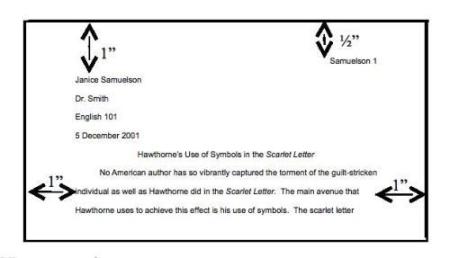MLA Style
The Modern Language Association (MLA) has created a standard set of rules that is used to organize research papers.
Overall Format
- Double-spaced lines
- Left-justified
- Standard, twelve-point, easily readable font
- One-inch margins on all sides
- Your last name followed by the page number in the upper right hand corner
- A centered title (it should not be underlined, in quotation marks, or in all capital letters)
- A heading on the upper left hand corner of the first page (your name, the professor, the course title, and the date—note the order for the date: day, month, year)

Parenthetical Documentation
Parenthetical documentation identifies the source of your information within the body of your paper. Parenthetical references in the text should clearly point to specific sources in the Works Cited list. Usually the author’s name and a page number are sufficient for identifying the source.
Statistics show that students who get fewer than six hours of sleep per night are less likely to perform well on tests than those who receive more than six hours of sleep (Jones 123).
If you refer to the author’s name within the sentence itself, there is no need to include his/her name in the citation; simply the page number is sufficient.
In his essay, Jones explains that “one effective way of combating depression is by exercising regularly” (4).
Note that the parenthetical citation precedes the period and follows any quotation marks. The only exception to this format is if the quotation is longer than four typed lines. In this case, there are no quotation marks, and the parenthetical citation follows the period (see example below).
If you include a quotation in your paper that is more than four lines long, you will need to set it apart from the rest of the text. You should begin the quotation on a new line and indent one inch from the left margin. The quotation should be double-spaced and should not be enclosed in quotation marks.
If you are citing a work that has more than one author or a work that is listed by its title, you will want to include the additional authors or the title in the parenthetical citation. For a more complete explanation of specific cases, refer to pages 184-205 of the MLA Handbook.
Works Cited Page
The last part of your paper is the Works Cited Page. This page is a list containing the publishing information of all of the works that you have cited in your paper. Put the list in alphabetical order according to the author’s last name, and double-space it. The first line of each entry is aligned with the left margin, and subsequent lines are indented half an inch. (Note format in the example below.) Use the following format for listing the publication information for a basic book by one author and for a magazine article:
Author’s Last Name, First Name. Title of Book. Place of Publication: Publishing Company, Year of Publication. Medium of Publication.
Author’s Last Name, First Name. “Title of Article.” Title of Magazine Date of Publication: Page Numbers. Medium of Publication.
For information on citing introductions, internet sources, books with multiple authors or volumes, videos, or other types of publications, consult section 4 of the MLA Handbook.
* All information has been taken from the MLA Handbook for Writers of Research Papers (7th Edition)